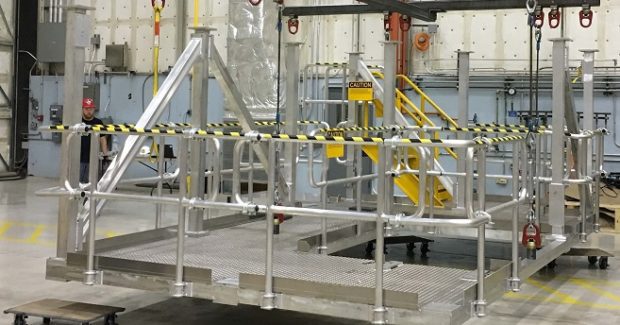Lifting Their Game to the Next Level
In the custom installation of this five-story work platform, the biggest challenge facing WB Industries was not in the design, fabrication and assembly of the platform itself, but installing it inside a secure area with only a single lift point.
Posted: August 17, 2018
Established in 1974, WB Industries (O’Fallon, MO) is a metal fabricator that builds and installs industrial work and office platforms, mezzanines, ladders, gates and rails as well as structural steel systems for construction that are used to improve safety, efficiency and performance in local, national and international manufacturing facilities, military bases, aircraft carriers, public areas and within the U.S. infrastructure. They typically receive orders for custom jobs – some with very particular requirements – and pride themselves on developing special solutions for complicated problems. For example, an aerospace customer requested the fabrication, assembly and installation of a five-story mobile work platform for a specific facility in New Orleans. On this job, the biggest challenge was not in the design, fabrication and assembly of the work platform itself, but rather in the field installation of the platform at the aerospace facility: the location of the platform had to be installed inside a secure area with only a single lift point. Due to the nature of this facility, there was no opportunity to utilize two lift points for more stability, so a viable solution was needed to overcome this obstacle.
The team got to work designing a custom lifting fixture that would properly interface with the customer’s crane. The material was cut using a Hydmech V-18 Series II band saw and many of the parts were machined prior to welding using a Mazak VTC-20B vertical machining center or Mazak Quick Turn 40 CNC lathe. Most of the structure was made from ASTM A36 carbon steel bars and angles, with the structural square tubing being certified to ASTM A500 Grade B. The hoist ring attachment blocks were made from 1018 cold rolled steel per ASTM A108. The fixture was designed with a simple geometry so that fabrication could be done with ease. The rounded corners of the A500 tubing provided natural flare bevel weld joints so that the project did not require beveling, but the material was sanded to remove surface oxides prior to welding to prevent weld contamination.
The structure was manually welded using GMAW with Miller CP-302 welding machines and a 22A feeder. The welding operators were certified to AWS D1.1. and followed qualified Weld Procedure Specifications (WPS). The filler metal utilized was a standard ER70S-6. The shop routinely uses 5 ft x 10 ft Weldsale platen tables and clamps for holding the structure during welding. The toughest hurdle the fixture presented was in the design. The team had to determine four non-critical areas on each level of the platform where the lifting hardware could be attached and find a common shape that would accommodate every attachment point on all four levels, all while making sure that each configuration did not interfere with the previous one. The team settled on an “H” design to allow each attachment point to float along the vertical axes, allowing the vertical members to reposition along the horizontal axis. Each attachment point was also adjustable to help balance the load accordingly.
The next issue was the actual installation in the field, specifically with the on-site crane. On two separate occasions, the crane stopped working with the load suspended in the air. The first time this happened was with the load about six feet off the ground; the second time the load was about 30 ft up, only inches from being in final position. The crane did not fail or drop the load, it just stopped. Facilities maintenance personnel had to come out and troubleshoot the problem to get the crane running again. Another difficulty was the forklifts the team rented to stage the material. At the time, people were working inside of one of the craft’s fuel tanks that was in close proximity to the work platform being installed, so the customer had a portable air conditioning unit pumping air into the tank. The forklifts were powered by diesel fuel and, since the customer had strict guidelines on air quality inside the tank, they were concerned the diesel fumes would be picked up by the air conditioner inlet and contaminate the air supply. The team worked with the on-site safety personnel to allow for short bursts of forklift activity to stage material and keep the project moving forward while they worked in parallel with the rental company to exchange the forklifts for propane-fueled models.
Ultimately, two platforms were built. Most of the component parts were made together, but the final assembly occurred on two separate occasions – roughly six weeks apart. The project took a total of 20 days to install and was completed on time and under budget. Tool design often focuses on the finished product and not the process it takes to get to that point. This was an example of being called on to design and develop a very customized, one-of-a-kind solution that could take a project from concept to reality.
WB Industries, 1270 West Terra Lane, O’Fallon, MO 63366-0485, 636-272-2366, Fax: 636-272-2368, info@w-bindustries.com, w-bindustries.com.




